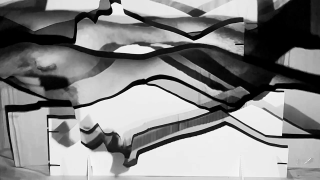'Field'- Canvas
Visual artwork
| Title | 'Field'- Canvas |
|---|---|
| Type of Work | Visual artwork |
| Creator/Contributor | |
| Visual artist | Fenton, David |
| Year | 2024 |
| Publisher or Commissioning Body | University of Southern Queensland Australia |
| Place of Publication | Australia |
| Web Address (URL) | https://www.rhijohnsonprint.com/fill-your-eyes-2 |
| Description of Work | Field- Canvas (2024) – NTRO Rationale This non-traditional research output is derived from a Performance Studies, intermedial exploration of de-anthropocentric performativity. The core problem of the research is ‘how can the body perform inside an assemblage of equally performing materials as an “intra-actant”?’* Theoretically, this inquiry is derived from theories of performatives, acknowledging Austin’s (1975) notion of the ‘performative’, wherein the ‘thing performs itself’, post-humanism i.e., ‘A post-humanist account calls into question the givenness of the differential categories of “human” and “nonhuman,” examining the practices through which these differential boundaries are stabilised and destabilised…’ (Barad, 2003: 808), and new materialism ‘…a term coined in the 1990s to describe a theoretical turn away from the persistent dualism in modern and humanist traditions whose influence are present in much cultural theory’ (Dolphijn et al., 2012, cited in Sanzo, 2018: 1). Specifically, Barad, through a post-structural feminist lens, emphasises ‘how matter comes to matter’ (2003). In this new materialist approach Barad recommends the operational paradigm of performativity. Barad states, 'Field – Canvas’ (2024) created by David Fenton as the sole artist/performer, is comprised of one still image derived from a previous NTRO series called ‘Field’ White-card. Within ‘Field’ white-card there are five chapters. The image for ‘Field – Canvas’ is derived from the first chapter entitled ‘Range’ (2024), which is an intermedial black and white performance of the researcher’s body embedded in an assemblage of white card diorama construction. The resulting research question that underpins this NTRO and others in the Field series is ‘How can an intermedial assemblage generate de-anthropocentric performance?’ This inquiry sits adjacent and at times complementary to other artist’s works, such as P-Chih Huange, Henrik Olesen, Ja Rhim Lee, and Frikkie Eksteen, who all challenge anthropocentric positionality i.e. those who challenge the ‘Anthropocene’ (Crutzen et al., 2011) an unofficial unit of geological time which is driven ‘by…anthropocentrically structured powers geared for exploitation of biological environments and material ecologies’ (29). New knowledge is manifest in the work as it materialises, performs and troubles the privilege of the body in contrast to the other materials in the composition. Thus, embodying the very notion of concerns of new materialism and post-humanism through performance. Other than manifesting the concerns of challenging the dominance of anthropocentric performance through a unique performative gesture, the work deepens the researcher’s inquiry by (as stated above) challenging the ontology of the performativity of the ‘still’ image itself. This engenders broader questions about the ontological status of performativity, forging a potential nexus between non-anthropocentric positionality, interdisciplinarity and intermediality (or as some would have it trans-materiality) in the researcher’s work. This NRTO extends the researcher’s creative practice in as much as it is an essential transitional work in the ‘Field’ series. ‘Field-Canvas’ is unsuccessful - in as much as it does not answer comprehensively its concerns - rather it is a gesture that manifests a new interdisciplinary, trans-material holding space for the research. It’s transitionary status as such, is also its success as research - as it provokes new ontological and formal challenges for the researcher/artist. By exhibiting what can traditionally be seen as an ‘artefact’, as opposed to a ‘performance’ the NTRO has opened up and troubled a space for greater theoretical and methodological potential for the overall ‘Field’ series. Specifically, the work has inspired new manifestations for ‘materialising’ the research question for example ‘what if the first and last frame of the performance were materialised as artefacts – could the space between these artefact hold for the viewer/audience/percipient an imagined performance? Would this then also be a performance totally deprived of the anthropocentric and the material? This calls into mind the work of Salvatore Garau’s invisible statue “I Am” (2021) which is akin to (Borevitz, 2003: 3) position on form, that being ‘The work before interpretation is formless and produces in the viewer an anxiety which must be resolved by attribution… [it is] an anxiety that demands resolution by the assignment of significance’. The work is significant to the field in as much as it is a clear transitional creative manifestation of the research inquiry which holds a main and sub-questions. To reiterate, the main being ‘How can an intermedial assemblage generate de-anthropocentric performance?’ the sub-questions being ‘Is the resulting artefact still a performance or rather simply performative?’ and ‘Can the work transcend the notion of performance and should it?’ The evidence rests (not unpredictably) partially in a subsequent NTRO work, generated from this new line of inquiry - the work entitled ‘Wounded Parties’ (2024) exhibited at the Resilience exhibition at St Andrew’s Hospital Toowoomba - which successfully combine the notion of Process Art in both artifact and performance. This work is directly attributable to the transitionary opportunities created by ‘Field-Canvas’ (2024) in exhibition. There were no collaborators, no funding, prizes, accolades and or peer reviews of the work. However, ‘Field - Canvas’ (2024) was accepted into the UniSQ Staff and Student exhibition ‘Fill your Eyes’ (2024) curated by Rhi Johnson and Peta Berghofer, which demands a particular standard of peer engagement – with its intent of exhibiting and exchanging works among artists as part of its curatorial rationale. I can confirm that the research was exhibited amongst artists of high standing who have considerable bodies of work, for example Rhi Johnson, Kyle Jenkins, Stephen Spurrier, and Linda Clark, Carolyn Drought-Leblang, Scott Henman, Cara-Ann Simpson and Danish Quapoor (to name but a few). References: Footnote: *. Here Barad takes her cue on the notion that “agency exists not as an influence of one pre-existing entity upon another but as an ‘intra-action’, a cooperative force that brings entangled materiality into being through their relationship” (Barad, 2007, cited in (Carranza, 2018 |
| Keywords | Performance, Performative, Presence |
| Contains Sensitive Content | Does not contain sensitive content |
| ANZSRC Field of Research 2020 | 360604. Photography, video and lens-based practice |
| Public Notes | File reproduced in accordance with the copyright policy of the publisher/author/creator. |
| Byline Affiliations | School of Creative Arts |
https://research.usq.edu.au/item/z5w9w/-field-canvas
Download files
121
total views69
total downloads1
views this month0
downloads this month
Export as
Related outputs
Congratulations, Get Rich! is a Glittering Ghost Story Where Emotion is Lost to Theatrics
Cantrell, Kate and Fenton, David Raymond. 2025. "Congratulations, Get Rich! is a Glittering Ghost Story Where Emotion is Lost to Theatrics." Conversation. https://doi.org/10.64628/AA.vth7ncvr9
Cold Whitman [Previous Owner]
Fenton, David. 2025. Cold Whitman [Previous Owner]. University of Southern Queensland.Dramaturgical Practice: 'My Two Blankets" Creative Development 1 & 2
Fenton, D.. 2024. Dramaturgical Practice: 'My Two Blankets" Creative Development 1 & 2. University of Southern Queensland 24 - 28 Jun 2024
'Field' (White-card) 2
Fenton, David. 2024. 'Field' (White-card) 2. Melbourne, Australia 12 Mar - 13 Apr 2024
